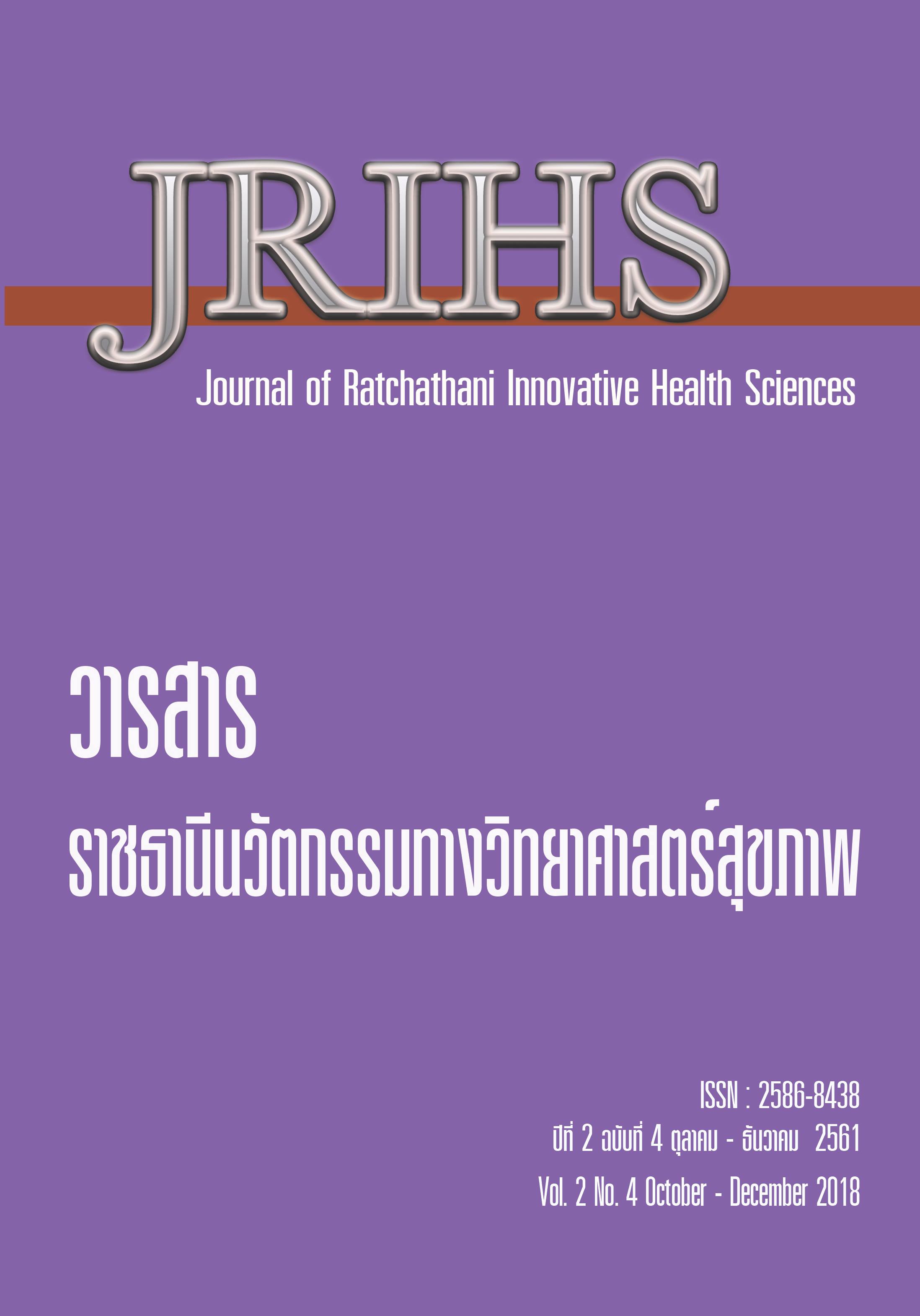Factors Associated with Glycemic Control Among People with Type 2 Diabetes Mellitus in Sub-district, Ubon Ratchathani
Main Article Content
Abstract
The Objective of this survey research was to study the relationship between personal factors, knowledge of diabetes, social support, health care behaviors and glycemic control in type 2 diabetes mellitus patients. The sample was 118 type 2 diabetes mellitus patients receiving services in diabetic clinic, Nong Kin Phen Tambon Health Promoting Hospital, Warinchamrab Ubon Ratchathani, during April-May 2018. Data collection instruments used in the study were questionnaires consisting of personal information, knowledge of diabetes, social support and health care behaviors. The reliability of the knowledge questionnaires was KR-20 = 0.67, social support and health care behaviors questionnaires was Cronbach’s Alpha Coefficient of 0.78 and 0.85, respectively. The data were analyzed by using frequency, percentage, mean, standard deviation and Chi–square test (x2). The result showed that the knowledge of diabetes, social support and health care behaviors were at high levels (60.17, 52.54 and 71.19 Percent, respectively). For the relationship study, the body mass index and the follow up by appointment were associated with glycemic control, statistically significant at the 0.05 level. However, there was no significant association between knowledge of diabetes, social support, health behavior and glycemic control. The results showed that the development of models of care for type 2 DM patients must take body mass index and the follow up by appointment, by focusing on the individual needs of the patients to response appropriately, leading to better self-care and blood sugar control among the patients.
Article Details
ความคิดเห็นและข้อเสนอแนะใดๆ ที่นำเสนอในบทความเป็นของผู้เขียนแต่เพียงผู้เดียว โดยบรรณาธิการ กองบรรณาธิการ และคณะกรรมการวารสารราชธานีนวัตกรรมทางวิทยาศาสตร์สุขภาพไม่ได้มีส่วนเกี่ยวข้องแต่อย่างใด มหาวิทยาลัยราชธานี บรรณาธิการ และกองบรรณาธิการจะไม่รับผิดชอบต่อข้อผิดพลาดหรือผลที่เกิดขึ้น จากการใช้ข้อมูลที่ปรากฏในวารสารฉบับนี้
References
ดวงใจ พันธ์อารีวัฒนา. (2561). ปัจจัยที่มีความสัมพันธ์กับการควบคุมค่าน้ำตาลสะสมในเลือดไม่ได้ของผู้ป่วยเบาหวานชนิดที่ 2 ในโรงพยาบาลบางแพ จังหวัดราชบุรี. วารสารแพทย์เขต 4-5, 37(4), 294-305.
ทรรศนีย์ สิริวัฒนพรกุล, นงนุช โอบะ, และสุชาดา อินทรกำแหง ณ ราชสีมา. (2550). ปัจจัยที่มีความสัมพันธ์กับระดับน้ำตาลในเลือดของผู้ป่วยเบาหวานชนิดที่ 2. วารสารพยาบาลศาสตร์ มหาวิทยาลัยนเรศวร, 1(2), 57-67.
ธนวัฒน์ สุวัฒนกุล. (2561). ปัจจัยที่มีความสัมพันธ์กับการควบคุมระดับน้ำาตาลในเลือดของผู้ป่วยเบาหวานชนิดที่ 2. วารสารวิจัยระบบสาธารณสุข, 12(3), 515-522.
ผุสดี ด่านกุล, พชรพร สุวิชาเชิดชู, และนิภาวรรณ ทองเป็นใหญ่. (2554). ความสัมพันธ์ระหว่างปัจจัยส่วนบุคคล ปัจจัยด้านพฤติกรรมการดูแลตนเอง ปัจจัยด้านการสนับสนุนกับการควบคุมระดับน้ำตาลในเลือดของผู้เป็นเบาหวานชนิดที่ 2 ในเขตพื้นที่รับผิดชอบ ของหน่วยบริการปฐมภูมิเครือข่ายเมืองย่า 5. นครราชสีมา. วารสารวิทยาลัยพยาบาลบรมราชชนนี นครราชสีมา, 17(2), 27-38.
โรงพยาบาลส่งเสริมสุขภาพตำบลหนองกินเพล. (2561). ทะเบียนผู้รับบริการโรคไม่ติดต่อเรื้อรังประจำปี 2561.
ละอองดาว คำชาตา, ชดช้อย วัฒนะ, และ ธีรนุช ห้านิรัติศัย. (2560). ผลของโปรแกรมการจัดการตนเองต่อพฤติกรรมการจัดการตนเอง เส้นรอบวงเอว ระดับน้ำตาลในเลือด และความเสี่ยงต่อการเกิดโรคหัวใจ และหลอดเลือดในผู้ที่มีกลุ่มอาการเมตาโบลิก. วารสารพยาบาลสาร, 44(3), 65-76.
โศรดา ชุมนุ้ย เเละคณะ. (2550). ปัจจัยที่มีผลต่อการควบคุมระดับน้ำตาลในเลือดของผู้ป่วยเบาหวานชนิดที่ 2 โรงพยาบาลร่องคำ อำเภอร่องคำ จังหวัดกาฬสินธุ์. วารสารวิจัยและพัฒนาระบบสุขภาพ, 1(3), 60-69.
สมาคมโรคเบาหวานแห่งประเทศไทย ในพระราชูปถัมภ์สมเด็จพระเทศรัตนราชสุดา สยามบรมราชกุมารี. (2561). แนวทางเวชปฏิบัติสำหรับโรคเบาหวาน พ.ศ.2560. สืบค้นจาก
https://www.dmthai.org/attachments/article/443/guideline-diabetes-care-2017.pdf
สุจิตรา บุญประสิทธิ์, สิริลักษณ์ โสมานุสรณ์, และชมนาด สุ่มเงิน. (2559). ปัจจัยที่มีความสัมพันธ์กับการจัดการตนเองในการควบคุมระดับน้ำตาลในเลือดของผู้สูงอายุโรคเบาหวานที่ควบคุมระดับน้ำตาลในเลือดไม่ได้. วารสารวิทยาลัยพยาบาลบรมราชชนนี กรุงเทพ, 32(1), 44-56.
สำนักงานสาธารณสุขจังหวัดอุบลราชธานี. (2561). บทสรุปผู้บริหาร คณะที่ 1 การส่งเสริมสุขภาพป้องกันโรคและคุ้มครองผู้บริโภคด้านสุขภาพ. สืบค้นจาก http://bie.moph.go.th/e-nsreport_ex/file_report/2018-08-21-09-19-05-11.doc
สำนักโรคไม่ติดต่อ กรมควบคุมโรค. (2559). ประเด็นสารรณรงค์วันเบาหวานโลก ปี 2559. สืบค้นจาก http://thaincd.com/document/file/info/non-communicable-disease
สำนักโรคไม่ติดต่อ. (2561). จำนวนและอัตราตายโรคไม่ติดต่อ ปี 2559-2560 (ความดันโลหิตสูง
เบาหวาน หัวใจขาดเลือด หลอดเลือดสมอง หลอดลมอักเสบ ถุงลมโป่งพอง). สืบค้นจาก http://www.thaincd.com/2016/mission/documents-detail.php?id =13486&tid=32&gid=1-020
อนุชา คงสมกัน. (2555). ปัจจัยที่มีความสัมพันธ์ต่อพฤติกรรมการควบคุมระดับน้ำตาลในเลือดของผู้ป่วยเบาหวานโรงพยาบาลรามาธิบดี. วารสารสุขศึกษา, 35(120), 62-73.
อมรา ทองหงส์. (2558). สรุปรายงานการเฝ้าระวังโรค ประจำปี 2558. สืบค้นจาก ttp://www. boe.moph.go.th/Annual/AESR2015/aesr2558/Part%201/11/diabetes.pdf
อุสา พุทธรักษ์ และเสาวนันท์ บำเรอราช. (2558). ปัจจัยที่มีความสัมพันธ์กับการควบคุมระดับน้ำตาลในเลือดของผู้ป่วยเบาหวานชนิดที่ 2 ที่เข้ารับการรักษาที่โรงพยาบาลส่งเสริมสุขภาพตำบลก้างปลา จังหวัดเลย. วารสารการพัฒนาสุขภาพชุมชน มหาวิทยาลัยขอนแก่น, 3(1), 20-35.
American Diabetes Association (2017). Classification and Diagnosis of Diabetes. Diabetes Care, 40(Suppl 1), S11-S24.
Krejcie, R.V. & Morgan, D.W. (1970). Determining Sample Size for Research Activities. Educational and Psychological Measurement, 30(3), 607-610.
Pablos-Velasco, P.D., Parhofer, K.G., Bradley, C., Eschwege, E., Gonder-Frederick, L., & Maheux, P. (2014). Current Level of Glycaemic Control and Its Associated Factors in Patients With Type 2 Diabetes Across Europe. Clinical Endocrinoogyl, 80(1), 47-56.
Pender, N.J., Murdaugh, C.L., & Parson, M.A. (2002). Health Promotion in Nursing Practice (4th ed). Upper Saddle River, N.J.: Prentice Hall.


